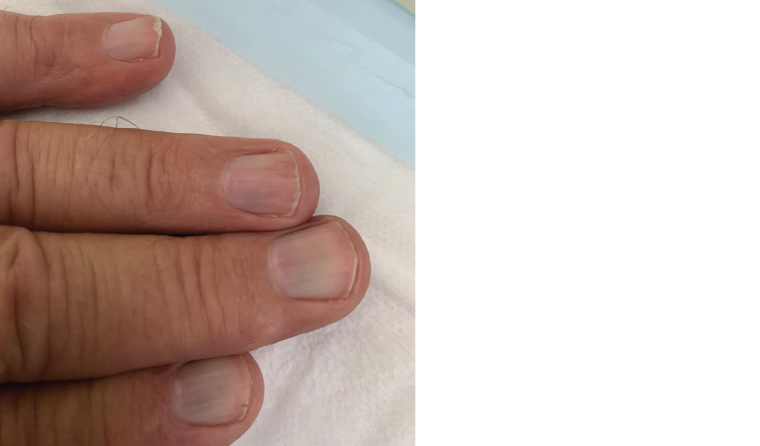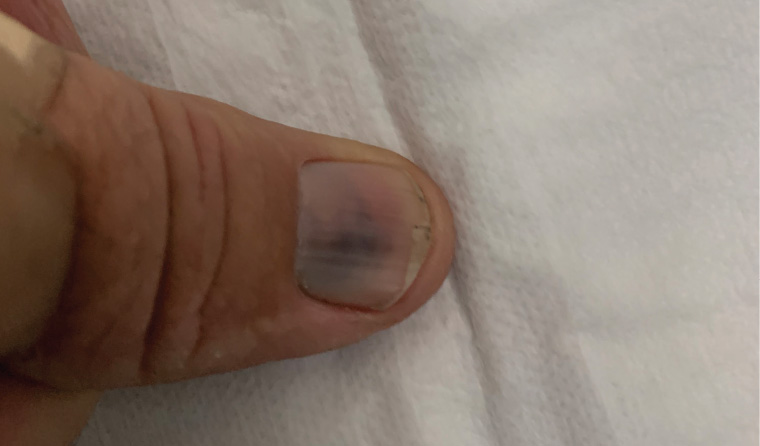Case
A man aged 62 years who worked as school cleaner presented with concerns of a blue-grey colouration to all his nails. He had first noticed this change several weeks ago. His fingers and toes were not painful and he could not recall any cause or trauma for the change. He did not have bruising or bleeding elsewhere.
On examination, there was an identifiable blue-grey tinge of varying degrees on the proximal aspect of all his fingernails and toenails (Figures 1 and 2). There were no other skin changes found. The remainder of his examination was unremarkable. The patient’s recent routine blood tests showed no abnormalities.
His current medical conditions and medications are summarised in Table 1.

Figure 1. The patient’s fingernails

Figure 2. The patient’s thumbnail
| Table 1. The patient’s current medications |
| Condition |
Medication and dose |
Duration |
| Systemic osteoarthritis |
Paracetamol 665 mg, two tablets three times per day |
Three years |
| Major depression |
Venlafaxine sustained release 150 mg once daily |
Five years |
| Hypertension |
Telmisartan 40 mg once daily |
Five years |
| Dyslipidaemia |
Rosuvastatin 20 mg once daily |
Five years |
| Rosacea |
Minocycline 50 mg once daily |
Intermittently but recurrently for 10 years |
Question 1
What is the likely diagnosis?
Question 2
What other conditions could be considered?
Answer 1
The likely diagnosis is medication-induced nail colouration secondary to prolonged minocycline use.
Answer 2
The differential diagnosis includes:
- medication-induced hyperpigmentation from another agent
- nail infection (eg onychomycosis or Pseudomonas spp.)1
- heavy metal exposure (eg colloidal silver)2
- idiopathic discoloration.
Case continued
A specialist dermatology review was organised. This confirmed the diagnosis of hyperpigmentation secondary to minocycline.
Question 3
How common is minocycline-induced hyperpigmentation?
Question 4
Which body areas can be affected by minocycline-induced pigmentation?
Question 5
What are the different types of minocycline-induced hyperpigmentation and the corresponding histopathological findings?
Question 6
What is the effect of dose and duration on the risk of developing hyperpigmentation?
Question 7
What other medications are associated with nail and/or skin colouration change?
Question 8
How should this condition be treated? Is the colouration likely to be permanent?
Answer 3
All tetracyclines (with the possible exception of doxycycline) have the potential to cause hyperpigmentation, but minocycline is the member of this antibiotic family most commonly associated with this side effect.1 Up to 20% of long-term (more than four years) users of minocycline will developed some form of medication-induced hyperpigmentation.3
Answer 4
Minocycline-induced pigmentation can occur in many different body areas, including:3
- cutaneous (skin, nails)
- oral cavity (teeth, mucus membranes, alveolar bone and hard palate)
- ocular (sclera, conjunctiva)
- skeleton and cartilage (vertebra, costal cartilage, parietal bone)
- viscera and body fluids (thyroid, aortic and mitral valves, athereosclerotic plaques, breast milk).
Answer 5
There are three types of minocycline-induced hyperpigmentation.3 These are summarised in Table 2.
| Table 2. Types of minocycline-induced pigmentation |
| Type |
Pattern of involvement |
Histopathology |
| Type I |
Blue-black macules in areas of existing scarring (eg past acne scars) |
Minocycline degradation products bound to haemosiderin, ferritin or iron |
| Type II |
Blue-black, brown or slate-grey discoloration of healthy skin; most notably affects anterior lower leg and ankle and arms |
Insoluble complexes of minocycline bound to iron |
| Type III |
Muddy-brown hue of a generalised and symmetrical distribution on healthy,
sun-exposed skin |
Melanisation of the basal cell; minocycline may be found without chelation to iron |
Answer 6
Type I hyperpigmentation is not affected by the dose and duration of minocycline use; however, types II and III are associated with a lifetime dose of >70–100 g.
Answer 7
Specific forms of nail changes have been associated with the following medications:1,4
- zidovudine, PUVA (psoralens), hydroxyurea and chemotherapeutic medications can cause brown or black transverse or longitudinal bands
- antimalarials such as hydroxychloroquine and chloroquine can cause a brownish colour change to the nail bed
- tetracyclines, including minocycline, can also cause a yellow transverse discolouring.
Other medications with the potential to cause skin hyperpigmentation include:4
- an extensive array of antineoplastic agents
- immunosuppressants including etanercept and cyclosporin
- hyaluronic acid
- psychotropics including phenothiazines (eg prochlorperazine, chlorpromazine) and olanzapine
- antidepressants including imipramine, amitriptyline, citalopram, sertraline and mirtazapine
- ophthalmic agents including latanoprost and bimatoprost.
In addition, colloidal silver, which is taken orally by some patients as a complementary medicine, can cause a blue-grey discolouration of nails and skin.2
Answer 8
The pigmentation is considered harmless but it is advisable to cease the implicated agent.3
Minocycline-induced skin changes, if present, generally resolve within months to years.4 Nail changes may resolve more slowly over many years or not at all.4
Case continued
One month after ceasing the minocycline, there was no discernible clinical change in the appearance of the patient’s nails. The patient’s rosacea remained quiescent during this period. If the rosacea were to flare, a topical agent (metronidazole 0.75% gel or azelaic acid 15% gel) or short course (up to eight weeks) of an alternative antibiotic (eg erythromycin) would be appropriate first-line options.5
Key points
- Medication-induced colouration change of the skin and nails is a well-recognised potential side effect of all tetracycline antibiotics (excluding doxycycline), particularly minocycline.
- The risk of developing medication-induced colouration change from minocycline increases with increased dose and duration of use.
- Should colouration change develop, the patient can be reassured the change is benign, but it is advisable to cease the offending agent.